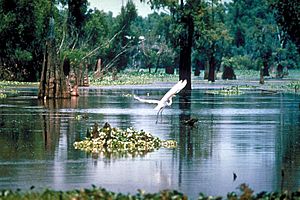Atchafalaya National Wildlife Refuge facts for kids
Quick facts for kids Atchafalaya National Wildlife Refuge |
|
|---|---|
|
IUCN Category IV (Habitat/Species Management Area)
|
|
| Location | Iberville / St. Martin parishes, Louisiana |
| Nearest city | Krotz Springs, Louisiana |
| Area | 15,000 acres (61 km2) |
| Established | 1986 |
| Governing body | U.S. Fish and Wildlife Service |
| Website | Atchafalaya National Wildlife Refuge |
The Atchafalaya National Wildlife Refuge is a special natural area in Louisiana. It is located about 30 kilometers (18 miles) west of Baton Rouge, Louisiana. You can find it just east of the Atchafalaya River. This refuge is part of a bigger area called the Sherburne Complex Wildlife Management Area. This complex was created in 1988. It brought together the Sherburne Wildlife Management Area, the Atchafalaya National Wildlife Refuge, and the Bayou Des Ourses (which means "Bayou of the Bears").
Contents
History of the Refuge
The idea of National Wildlife Refuges started in 1903. President Theodore Roosevelt created the first one, Pelican Island National Wildlife Refuge in Florida. The Atchafalaya National Wildlife Refuge became part of this system in 1986.
This system now protects over 150 million acres (607,000 square kilometers) of land. The Atchafalaya Refuge was set up for a few important reasons:
- To protect and manage all the fish and wildlife in the area.
- To help the United States keep its promises about protecting wildlife with other countries.
- To offer chances for scientific research and learning about nature.
- To provide fun activities like hunting, fishing, trapping, birdwatching, and nature photography.
Wildlife and Nature
The Atchafalaya National Wildlife Refuge is part of a huge area of swamps, lakes, and bayous. This natural floodplain stretches for 140 miles (225 kilometers) from the Mississippi River to the Gulf of Mexico.
The basin has many different kinds of trees. These include bottomland hardwoods, Bald Cypress-Tupelo swamps, and overflow lakes. This creates a home for over 200 types of birds. Many other animals also live here. This area is so important for birds that it's known as an Internationally Important Bird Area.
Animals of the Refuge
The wet forests here are vital nesting spots for wood ducks. They also support the largest group of American woodcocks in the country. You might even see Bald eagles, ospreys, or swallow-tailed kites flying high above.
Many mammals live in the refuge too. These include Wild turkeys, white-tailed deer, and different kinds of squirrels. You can also find Eastern cottontail rabbits, swamp rabbits, and foxes. Coyotes, striped skunks, and Virginia opossums are also present. A small group of Louisiana black bears also calls this place home. Other animals that live here are raccoons, mink, bobcats, coypus, muskrats, North American river otters, and North American beavers.
Fish and Water Life
The yearly floods and dry periods are very important for the fish here. The area floods during winter and spring rains. Then, many parts slowly dry out during summer and fall.
Fishing is very popular in the basin. People often try to catch Largemouth bass, white crappie, and black crappie. Other popular fish include warmouth, bluegill, redear sunfish, and channel catfish. More than 85 types of fish live in the basin. There are often huge numbers of them! Red swamp and white river crayfish are also important for both fun fishing and commercial harvesting.
Refuge Trees
The refuge covers about 44,000 acres (178 square kilometers). This land is mostly bottomland hardwoods. There are four main groups of trees found here:
- Eastern cottonwood and American sycamore.
- Oaks, gum (like sweetgum), hackberry, and Green ash.
- Black willow, bald cypress, and Pumpkin ash.
- Overcup oak and Bitter pecan (or water hickory).
The 2011 Flood
In 2011, the Mississippi River had a big flood. Because of this, the Morganza Floodway was opened. This caused the Atchafalaya National Wildlife Refuge to close to the public on May 14, 2011. This was the first time since 1973 that the Mississippi River was sent through the basin like this.
Most of the refuge stayed closed for a while. However, a part called the South Farm in Iberville Parish reopened on July 1, 2011. People could walk in or use ATVs there. The rest of the area remained closed until further notice.



